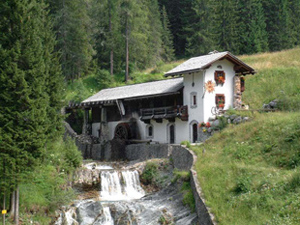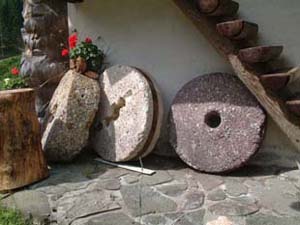| Card n. | Description | Locality | Linked sites |
| 2 | Cottrer sawmill | Cima Sappada | 67 |
| file .pdf | Ethnographical Sites (SE) | Google maps |
 |
 |
 |
- Description
- How to get there
- Interesting facts
- Bibliography
The Cottrer sawmill (Kòttrar soge), which lies along the flow of the Piave, close to the village, takes its name from its last owners, who, once the business closed down, sold it to the current owners, who renovated it. This nineteenth-century sawmill was powered by water; just a short distance further north, amid the woods in the direction of the Val Sesis, is another type of mill (s’Jacklars mihle), now renovated and used as a second home. Of this mill, already mentioned in the 1821 land registry map, three large wheels remain on the side facing onto the Piave, which were once powered by the water; a brief stretch of irrigation ditch can also be seen. In the last century, there were four sawmills in Sappada: the Cottrer in Cima Sappada, the Hoffer, a more recent municipal sawmill in the Bach neighbourhood and one in Borgata Lerpa, which was swept away by the flood in 1951. One of the numerous original, interesting houses in Sappada (Sindar mihle), situated after the first bridge over the Piave, conserves traces of the old water mill; also still visible is the mill (Milpar mihle) at the Mühlbach (meaning “brook of the mills”) Falls, which has not been in use for over half a century.
The sawmill lies north of Cima Sappada, on the bend of the Piave, at the mouth of the Val Sesis.
ACCESSIBLE: from the outside
MUNICIPALITY: Sappada
PLACE: Cima Sappada neighbourhood
GEOGRAPHICAL COORDINATES: X 1785326 – Y 5164534
PROVINCE: Belluno
FILE COMPILED BY: Lonzi
Scattered throughout the fifteen neighbourhoods are twenty or so fountains, which have been restored in recent years. Almost all of them date back to the early 20th century, and were built to replace older constructions in wood. The fifteen neighbourhoods that make up Sappada conserve some interesting examples of the “blockhaus” building technique, in which horizontal wooden beams are jointed together on masonry foundations. One such example is the Country Civilisation House Museum in Borgata Cretta; also worth a visit are the Fontana Ethnographical Museum in Cima Sappada and the small Great War Museum.
Various Authors, Nuova guida di Sappada / Plodn, Pieve di Cadore, 2010
A. Peratoner, Le antiche borgate di Sappada/Plodn – Die alten Weiler von Sappada/Plodn – The Old Villages of Sappada/Plodn, Pieve di Cadore, 2004

